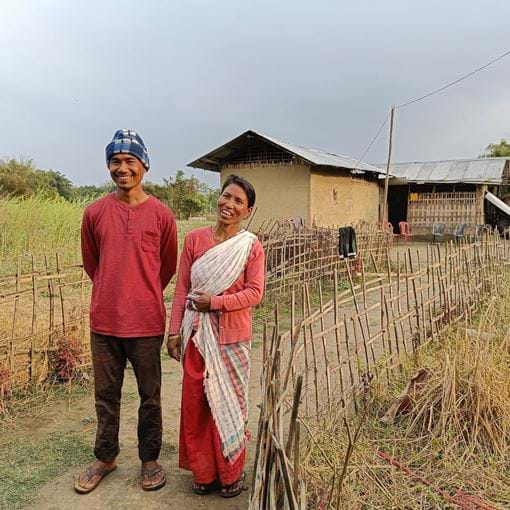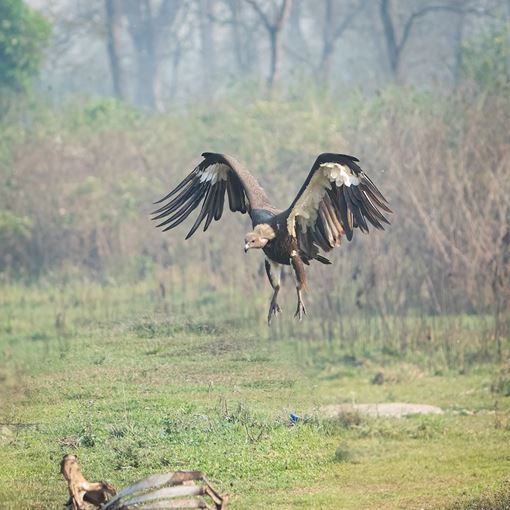Conservation
South Asia, one of the most diverse regions on the planet, houses nearly 15.5% of the world’s flora and 12% of the world's fauna, and many communities depend on this biodiversity for their livelihoods.

Preserving and restoring biodiversity ensures that both humans and wildlife can thrive alongside each other.
The opportunity
South Asia is in a unique position to develop innovative and sustainable solutions for the loss of biodiversity, due to the intricate interdependence of humans and natural habitats in the region. It stands to lose 6.5% of its GDP if key ecosystems collapse, potentially exacerbating poverty.
Biodiversity is fundamental to our collective well-being and therefore it’s essential that we safeguard our natural resources and foster their sustainable use.
Our solution
We aim to leave behind a legacy for wildlife, preserve biodiversity, and foster coexistence between people and the wildlife they share spaces with. In partnership with leading indigenous conservationists, we champion pioneering and innovative landscape-level initiatives revolving around the key pillars of community, connectivity, and collaboration.
Our focus areas include:
- Landscape-level interventions in target regions, including habitat restoration, protection of natural carbon sinks, and connecting fragmented corridors.
- Local community engagement to raise awareness around conservation and human-wildlife coexistence.
- Driving sustainable livelihood opportunities for local communities to meet their development needs while reducing their dependence on resources from wildlife habitats.
- Government engagement and sector building for improved policies, learning and knowledge generation and dissemination.

Our programmes
- Creating viable habitats in the Western Ghats with the Holématthi Nature Foundation: The Western Ghats are one of the world’s most significant biodiversity hotspots. By reconnecting forest fragments and corridors that support wildlife movement for resources, our work is creating viable habitats for the 300+ globally threatened species who live in the area. This programme, led by award winning conservationist and our long-term partner, Dr Sanjay Gubbi, has achieved the largest expansion of protected areas in India since 1970 by linking together 23 areas of land and thousands of square kilometres.
Through awareness and livelihoods initiatives, the programme also aims to reduce human-wildlife conflict. We have distributed energy-efficient solar water heaters and LPG kits among communities in the area, leading to a 69% reduction in the usage of firewood. This ensures that community members venture less into the forest, thereby avoiding incidents of HWC and protecting trees and plants for consumption by elephants and other animals. - Facilitating coexistence in human-elephant conflict hotspots (HEC) in Northeast India with Aaranyak: In Myanmar, we have supported a programme to teach communities how to avoid conflict with elephants and protect their crops. Building on the success of this work, we are facilitating coexistence in six major HEC hotspots in Assam and Meghalaya, with support from the UK Government’s Biodiversity Challenge Funds.
The programmes are educating communities about elephant behaviour, HEC, and how to protect people, property, wildlife, and biodiversity. Our efforts have resulted in 50% of households in HEC-affected project villages committing to coexistence.
To date, we have supported setting up 11.5 km of community-managed temporary solar electric fences and distributed solar lights for mitigating HWC. We have also offered training and materials to community members from 364 households to develop the necessary skills for alternative livelihoods, to offset losses from HEC. - The Coexistence Fund to support conservation initiatives in India: In 2022, we launched the CoExistence Fund, made possible through Elephant Family’s CoExistence campaign. The Fund supports conservation work that reimagines the relationship between humans and wildlife into one of co-existence rather than conflict and develop conservation solutions that are rooted in the ethos and ecological knowledge of local communities. The initiatives supported by the Fund include the following:
- Supporting innovative research on coexistence with the Coexistence Fellowship: The first initiative we supported through the Fund is the innovative Coexistence Fellowship Programme. We are working with 24 bright young fellows across the country, who are studying and documenting the different paradigms of coexistence and conflict with species such as elephants, snow leopards, sarus cranes, wolves, leopards, and hyenas.
- Restoring woodland savannas drawing from the traditional knowledge of the Soliga community (Karnataka) with ATREE: The Ashoka Trust for Research in Ecology and the Environment is developing a plan to co-manage the restoration of landscapes invaded by Lantana camara, a flowering plant native to the Americas, by documenting and developing ecological knowledge with the Soliga people in Karnataka.
- Connecting fragmented populations of the golden langur with Conservation Himalayas: Mass destruction of forest land has limited the habitats of golden langurs to fragmented landscapes, leading to human-monkey conflict when the langurs encounter human infrastructure or agriculture. With Conservation Himalayas, we are building canopy bridges that connect these fragmented populations of langurs, enabling them to move within their habitats and avoid human settlements.
- Creating safe spaces for people and wildlife with the Wildlife Conservation Trust: With WCT, we’re expanding our conservation efforts to central India, a region rich in biodiversity, and vital for the survival of iconic species like tigers. We will focus on reducing forest degradation and minimising human-wildlife conflict. Our solutions are simple but effective, such as addressing the development needs of communities, providing alternatives to firewood acquired by cutting down trees that animals use for food, and identifying more corridors to facilitate the movement of wildlife.
- Preserving our natural carbon sinks with Living Carbon International: Climate change and biodiversity loss are inextricably linked, as degraded landscapes lose their capacity to hold on to carbon, which in turn, affects the climate. With Living Carbon, we’re exploring the convergence of climate change and conservation. Through regenerative agriculture and other practices, we aim to regenerate ecosystems and restore our natural carbon sinks to contain the effects of climate change.















